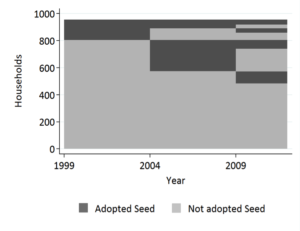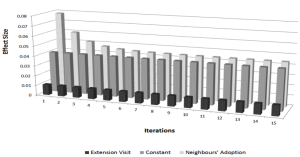
Neighbours and extension Agents in Ethiopia: Who matters more for technology diffusion?
Improving agricultural productivity is seen as vital to economic growth in poor countries, particularly in sub-Saharan Africa where productivity growth has lagged behind that of other continents. The focus has therefore been on new technologies, particularly the adoption and diffusion of improved seed varieties and the increased use of fertiliser, supported by investments in effective extension services. It is important to understand how these new technologies spread and the effectiveness of extension services in this process.
We examine the role of learning from an agricultural expert promoting technological adopotion (usually termed `extension agents’) versus learning from neighbours in increasing technological adoption (Krishan and Patnam 2012). We use data from the Ethiopian Rural Household Survey between 1999-2009 and exploit the structure of spatial networks of farmers and panel data to identify these influences. In doing so, we offer results of policy relevance for Ethiopia and beyond.
The Ethiopian government has placed agricultural growth at the centre of its growth strategy. It has put forward ambitious targets for increasing the use of chemical fertiliser and improved seeds in its recent development plans, such as the Plan for Accelerated and Sustainable Development to End Poverty (PASDEP) and the Growth and Transformation Plan, and it spends 1% of GDP on extension services. However, as in much of sub-Saharan Africa, the adoption of such technologies has been slow. The current level of improved seed use in Ethiopia is around 5% of cereal area, which is double that of 1997-98 but is still undoubtedly low. Fertiliser is applied to 39% of the total land area cropped with cereals, an increase from 32% in 1997-98 but below the levels achieved in 2001-02 (CSA data, 1998, 2003 and 2008). Figure 1 illustrates the complex dynamics of seed adoption amongst farmers in Ethiopia. Adoption is more likely one-off rather than sustained. Only 7.5% of new seed users in 1999 continued to use new seed in 2009. Only 4% of new seed users in 1999 continued to use new seeds thoughout the period, i.e. both in 2004 and 2009. . The key issue appears to encourage more farmers to use chemical fertiliser and improved seeds and to sustain their adoption rates.
The traditional explanation for the observed differences in the adoption of new technology is that some people are simply more receptive or entrepreneurial than others. Another possible explanation is imperfect information about the returns to a new technology and the consequent importance of learning. Two mechanisms to overcome this are typically studied: learning from social networks of peers (social learning) and extension services. While most studies look at each mechanism separately, we compare the role of the two. Additionally, we offer a first evaluation of the effectiveness of extension services in boosting technological adoption in the context of large investments in the services by the Ethiopian government.
Our focus is on understanding how a farmer's decision to adopt a new technology is influenced by his/her exposure to extension services and by the adoption behaviour of his/her neighboring farmers (peers). To empirically identify and estimate these effects, we use recent techniques in the empirics of social networks that allow us to distinguish the direct effect of peer learning from correlated effects whereby peers behave like each other simply because they have similar (unobserved) characteristics or face similar shocks. A further complication are the selection effects that arise when an individual chooses his or her own peer/reference group; these cause a bias in the peer effect due to the presence of unobservables that influence both the choice of peer group and the outcome. We deal with this issue by using repeated observations over time for the same farmer, which allows us to difference out time-invariant selection related unobservables (such as choosing to locate next to technologically advanced farmers with the view to emulate their experience) as well as control for the fixed sources of heterogeneity (such as localize extension services in affluent neighbourhoods) in the placement of extension services.
We find that there is a strong relationship between the adoption decisions of a farmer’s neighbours and his or her own decision to adopt new seed. An increase of one standard deviation in the average rate of adoption among neighbours raises the probability of own adoption by about 11% in 1999, by 19% in 2004 and by 12% in 2009. Average adoption percentages range from - 18-23%, so this is large (more than double current levels).
In contrast, an increase of one standard deviation in the number of visits by extension services (by 1.3 visits in 1999) raises the probability of new seed adoption by 3.7%, falling to 1.3% in 2004, while in 2009 this effect is at 2.9% (where 1 standard deviation is now 10 visits). These results also show that there is a clear collapse in the return to a visit, for those not yet visited: the increased probability of adopting in 2009 is only one-tenth what it was in 1999. Clearly, the decisions of neighbours outweigh any impact of extension services.
The evidence suggests that social learning is a powerful force for the adoption of new technologies and is far more persistent than learning from extension services over this period. We find that while the returns to extension may have been high in Ethiopia in 1999, by 2009 they appear to have collapsed to very low levels. The extension model of this period with a high intensity of visits may transmit useful information to the farmers, but as a way of encouraging modern input adoption, it does not appear to be very effective. This is not inconsistent with the general evidence on extension services, which suggests that they have an important role in raising awareness in the early stages of adoption but that their impact on diffusion falls over time. In brief, it is clear that the simple expansion of extension services that has been seen recently (at a cost of over 1% of GDP) has simply not paid off.
The low adoption, especially of seeds, may suggest that there has been a problem with the model of extension in Ethopia in recent years. However, it is also consistent with the view that after an early boost from extension, adoption will largely be through social learning. Social learning appears to be mainly about farmers identifying for themselves, from their own and their neighbours’ experiences, whether it is profitable to adopt new seed and to use fertiliser. Since adoption rates are stagnant, it seems there are other constraints preventing adoption. Constraints on the supply of seeds are very likely, while for fertiliser profitability may be low at current prices, given both limited seed supply and concerns over quality.
A final question centres around the impact of extension through diffusion: given that extension visits start a cycle of learning, shouldn’t a proper assessment of their impact include the indirect effects that the initial visits generate? To examine this, we simulate the impact on learning, accounting for fixed effects, using a simple adaptive model of learning as in the hog cycle model. The figure below depicts the probability of adopting over repeated rounds of exposure to three distinct factors: no intervention (constant), visit by an extension agent and the proportion of neighbours’ adopting. In the absence of both extension services and learning from neighbours, adoption is determined entirely by farmers’ own, fixed characteristics, which implies an adoption rate of 1.9% (the value of the constant in the regression). Without any learning from extension but allowing for learning from neighbours, the long-run equilibrium level of adoption is 7.5%. Further adoption requires an injection from another source: the initial average number of extension visits (0.27), while potent, adds only an extra percentage point to the initial adoption level of 1.9%. While the visits get a learning cycle going via social learning, the process is slow; after 10 iterations, only 9% extra is added to the initial 17% adoption rate. Learning from neighbours dominates, and the independent effect of extension is small because the number of visits is low. With the same learning technology and the same marginal effect of extension, boosting extension visits to 1.06 on average (as in 2004) would have a substantial impact. Here, after one iteration, 4% would have been added, and after 10 iterations, over a third of the sample would have adopted new seed. Finally, at a level of 5.5 visits (the 2009 average), one would see two-thirds adopting after only 4 iterations!
In short, the return from the expansion of extension has had no impact on the speed of adoption, and adoption is still dramatically low. Furthermore, though social learning is crucial, its impact is also not high enough to be self-sustaining either.
Conclusions
We find that in the initial period, both neighbours and extension agents mattered for the adoption of new seed, but the impact of adoption by neighbours is about three times as high, with an increase of one standard deviation in average adoption of improved seeds by neighbours. This conclusion is important for policymakers and offers further credence to evidence suggesting other approaches to evaluating extension services both in Ethiopia and elsewhere in sub-Saharan Africa. The expansion of extension services has been an important plank in the agricultural strategy of the Ethiopian government over the past decade. Since 2011, the government has attempted to restructure the role of extension services and the new model appears to focus on targeting a farmer and his closest spatial neighbours, which mirrors the identification strategy that we have pursued here. There is also an intent to create extension packages that are more specific to their settings and an attempt to transmit information that covers a range of management practices. Our evidence suggests that this is likely to be a move in the right direction, but the impact of this strategy is yet to be seen.
Further reading
Krishnan, P and M Patnam (2012), “Neighbours and extension Agents in Ethiopia: Who matters more for technology diffusion?”, IGC Working Paper No. 12/0159.



